MARKETING
10 Smart Ways to Save Money on Digital Marketing Tools

One of the biggest challenges for small businesses is finding affordable digital marketing tools that don’t break the bank. However, with a little research, you can find many cost-effective options that still provide valuable features to help grow your business. One way to save money is by using free or low-cost social media management tools like Hootsuite or Buffer. These platforms allow you to schedule and publish posts across multiple social media channels, track engagement metrics, and monitor brand mentions.
Another way to cut costs is by using email marketing software like Mailchimp or Constant Contact. These programs offer features such as customizable templates, automation workflows, and analytics tracking at an affordable price point. Additionally, utilizing Google Analytics for website traffic analysis can provide valuable insights into your audience’s behavior without spending a dime on expensive third-party tools.
It may be tempting to invest in pricey digital marketing tools in hopes of achieving bigger returns on investment (ROI), there are numerous cost-effective options available that can still deliver results. By leveraging free or inexpensive social media management and email marketing software along with Google Analytics data analysis capabilities, small businesses can effectively market their products and services without breaking their budget.
1. Prioritize Your Needs
One key thing to keep in mind when it comes to saving money on digital marketing tools is to prioritize your needs. There are countless tools available today, each designed to meet different needs and objectives. Before you invest in any tool, take the time to assess your business requirements and determine which ones are most critical for achieving your goals.
For instance, if your primary goal is to increase website traffic or generate leads, investing in a high-quality email marketing platform may be a more valuable investment than an expensive social media scheduling tool. By prioritizing what you need most based on your specific business objectives, you can avoid overspending on unnecessary tools that won’t provide much return on investment.
Another way to prioritize your needs is by focusing on the most important features of each tool. Prioritizing the functionalities that align with your goals will help you make more informed decisions about which tools are worth investing in and which ones aren’t necessary for meeting your specific needs.
2. Advantage of Free
- Sign up for Free Trials: Many digital marketing tools offer free trials that allow you to test their features and functions before committing to purchasing them. Take advantage of these free trials, and make sure you have a clear understanding of what the tool can do for your business.
- Use Free Versions: Some digital marketing tools offer free versions with limited features that are perfect for small businesses or startups on a tight budget. While they may not have all the bells and whistles of premium versions, they can help you get started without breaking the bank.
- Attend Webinars & Workshops: Many digital marketing tool providers offer free webinars and workshops where they share tips, tricks, and best practices on how to use their tools effectively. Attending these sessions can help you learn more about the tool’s capabilities while also giving you valuable insights into industry trends.
- Utilize Open-Source Software: Open-source software is a type of software whose source code is available to anyone who wants to modify or enhance it. This means that many digital marketing tools can be customized according to your specific needs without any additional cost.
- Learn from Free Resources: A quick search online will reveal countless blogs, articles, podcasts, and videos related to digital marketing tools and strategies that are entirely free of charge. These resources provide valuable information on how to use specific tools while also offering insights into effective digital marketing practices in general.
3. Research and Compare Prices
There are many different tools available for various aspects of digital marketing, ranging from social media management to email marketing automation. With so many options out there, it’s important to do your research and compare prices before committing to a particular tool.
One way to start your research is by browsing online review sites such as Capterra or G2 Crowd, which offer user reviews and comparisons of various digital marketing tools. You can also check out the websites of different vendors to compare pricing plans and features side-by-side.
When comparing prices, be sure to take into account any discounts or promotions that may be available. Many companies offer special deals for new customers or during certain times of the year, such as Black Friday or Cyber Monday sales. By doing your research and comparing prices carefully, you can save a significant amount of money on digital marketing tools while still getting all the features you need for your business.
4. Look for Bundles
Many software providers offer bundle deals that include multiple products for a discounted price. For example, if you’re looking for email marketing software, you might find a bundle deal that includes social media management and website analytics tools as well.
These bundles can be a great way to save money and get more bang for your buck. Not only do they often come at a discounted price, but they can also help streamline your workflow by providing all the tools you need in one place.
It’s important to make sure that the bundle deal is actually saving you money though. Be sure to compare the cost of buying each tool individually versus purchasing them in a bundle deal. Also, make sure that all the tools included in the bundle are ones that you will actually use – there’s no point in paying for something you don’t need just because it comes in a package deal.
5. Use Free Tools
One of the smartest ways to save money on digital marketing tools is by utilizing free tools. There are a plethora of free resources available online, and taking advantage of them can help your business save money without sacrificing quality or performance. For instance, Google Analytics is a powerful tool that provides valuable insights into website traffic and user behavior. It’s completely free to use, and it can help you optimize your website for better user engagement.
Another great free tool to consider is Canva. This graphic design platform allows you to create stunning visuals for social media, email marketing campaigns, and more without any design experience required. With its intuitive drag-and-drop interface and a library of templates, images, fonts, and icons at your disposal, Canva empowers businesses with limited budgets to create professional-looking designs that stand out from the competition.
Lastly, Hootsuite is a social media management tool that offers both free and paid plans. With the free version, you get access to basic scheduling features across three social profiles. It also includes basic analytics reports so you can track your social media performance over time. By using these types of free tools in combination with paid options strategically chosen based on the specific needs of your business model — such as email automation software or SEO optimization services — you can make every dollar invested in digital marketing go further while still achieving impressive results!
6. Pay Annually
Many vendors offer a discount when you pay annually instead of monthly. This is an excellent way to save money on digital marketing tools. However, be mindful of the commitment you’re making. Ensure the tool aligns with your marketing goals before committing to an annual payment plan.
7. Join Facebook Groups
Join Facebook groups related to digital marketing to network with other business owners and learn about deals and discounts. These groups are an excellent way to stay informed about the latest digital marketing tools and strategies.

In addition to tool recommendations, Facebook groups can provide valuable industry insights and trends that can inform your marketing strategy. By joining a group in your niche, you can stay up-to-date on the latest developments and changes in your industry. This information can help you optimize your digital marketing efforts, which will ultimately save you time and money.
8. Use Discount Codes
When making a purchase, look for discount codes online. Many vendors offer discount codes that can be applied at checkout to reduce the cost of the tool. For example, you can claim a Teachable course discount code or browse a BIGVU coupon code here. These codes can help you save money on your digital marketing tools.
9. Avoid Duplicate Tools
Digital marketing tools is essential to help grow your business online. However, it can be tempting to use a variety of different tools for similar tasks. This can lead to duplicate tools that will cost you more money than necessary.
Avoiding duplicate tools means you need to evaluate each tool carefully before purchasing or subscribing. Look for features that are unique and necessary for your business needs. Consider the number of users who will be using the tool, how often it will be used, and if there are any hidden costs such as upgrades or maintenance.
10. Reassess Your Needs Regularly
Regularly assess your digital marketing needs to ensure you’re only paying for tools that are essential to your business. As your business grows, your marketing needs may change. Be mindful of these changes and adjust your digital marketing toolset accordingly.
Conclusion
Digital marketing tools are essential for growing your business and reaching customers. However, they can be expensive, and small businesses may struggle to justify the cost.
By prioritizing your needs, taking advantage of free trials, researching and comparing prices, looking for bundles, using free tools, paying annually, joining Facebook groups, using discount codes, avoiding duplicate tools, and reassessing your needs regularly, you can save money on digital marketing tools without sacrificing quality.
In conclusion, digital marketing tools can be expensive, but there are ways to save money without compromising the quality of your marketing efforts. By following the tips outlined in this article, you can ensure that you’re only paying for tools that align with your marketing goals and budget. Additionally, take advantage of the many deals and discounts available online, such as the Teachable course discount code or Browse a BIGVU coupon code here, to further reduce the cost of your digital marketing tools. With careful planning and smart decision-making, you can build a cost-effective digital marketing toolkit that helps your business thrive.
MARKETING
Tips and Tricks for Digital PR

In the bustling digital landscape of the 21st century, public relations (PR) stands as a beacon of brand visibility, trust-building, and reputation management. As businesses navigate the complexities of online competition, the synergy between search engine optimization (SEO) and PR has become increasingly evident. This article delves into digital PR, exploring how strategic integration with SEO practices can elevate brand visibility, drive organic traffic, and amplify PR success.
The SEO & Digital PR Power Couple
In today’s digital landscape, success hinges on a strong online presence. Two crucial aspects of achieving this are SEO and Digital PR. While they may have functioned as separate strategies in the past, they’re now recognized as a powerful team.
SEO focuses on optimizing your website and content to rank higher in search engine results, driving organic traffic. PR, on the other hand, builds brand awareness and cultivates positive press mentions.
However, creating compelling content that resonates with audiences and search engines can be challenging for many PR professionals. A recent Institute for Public Relations study found that nearly three-quarters (70%) of PR practitioners struggle with content creation. This is where the magic of SEO and digital PR working together comes in.
Combining these forces creates a synergy that delivers impressive results. Effective SEO techniques in PR campaigns can amplify brand messaging and ensure it reaches the right audience through search engines.
Conversely, strong PR efforts can generate backlinks to your website, a significant factor influencing SEO ranking. This teamwork propels brands to industry leadership by establishing online authority and positive brand sentiment.
Optimizing Your PR Efforts for SEO
PR and SEO go hand-in-hand in today’s digital marketing landscape. By aligning your PR activities with SEO best practices, you can significantly boost your online presence and reach a wider audience. Here’s how:
Keyword Research
Just like any successful marketing campaign, PR needs a strong foundation. Keyword research is crucial for understanding the language your target audience uses online. According to Google, more than half of consumers (53%) consult online resources before purchasing a product or service.
This includes potential students researching educational options. For instance, terms like “best online degrees for 2024” can be valuable keywords for online schools to target in their PR efforts to reach potential students actively searching for programs.
By identifying relevant keywords with high search volume, PR professionals can craft messaging that resonates with their audience and increases the discoverability of their content in search results.
Content is King (and Queen)
Compelling and newsworthy content is the cornerstone of any successful PR campaign. But for SEO, it’s not just about capturing attention.
High-quality content, such as press releases, blog posts, and infographics, should also be optimized for search engines. This includes using relevant keywords strategically throughout your content and adhering to on-page SEO best practices. By creating content that is both informative and search-engine friendly, you attract not only readers but also valuable backlinks and organic traffic.
Building Backlinks
Backlinks are links from other websites pointing back to yours. Search engines consider backlinks a sign of trustworthiness and authority.
Strategic PR campaigns can help you secure these valuable backlinks by pitching newsworthy content to relevant websites, building relationships with journalists and influencers, and leveraging social media to promote your content. However, focusing on earning backlinks from reputable sources is crucial, as spammy tactics can hurt your SEO efforts.
Optimizing Media Coverage
Every media placement you secure, whether an article, interview, or social media mention, presents an opportunity to enhance your SEO. Encourage journalists and influencers to include relevant keywords and links to your website in their coverage.
Promoting these media placements on your social media channels can amplify their reach and drive more organic traffic to your website.
Advanced SEO Techniques for PR Success
Today’s audiences crave engaging content; SEO is crucial to seeing your message. Incorporating advanced SEO tactics into your PR strategy can amplify your reach and achieve tremendous success.
Leveraging Multimedia
We’re living in the age of visual storytelling. Eye-catching images, infographics, and videos aren’t just trends; they’re powerful tools for grabbing attention and boosting SEO.
A Demand Metric report highlights the power of video marketing for conversions. 93% of marketers agree that video is just as practical, or even more effective, at driving conversions compared to other content formats.
These elements enhance user experience and provide opportunities for keyword optimization. Descriptive alt tags and strategic file names can help search engines understand your content and improve your ranking for relevant searches.
Data-Driven PR
Gone are the days of guesswork in PR. You can achieve laser focus and maximum impact by integrating SEO data with your PR strategy. Tools like keyword research can help you identify topics and language your target audience is actively searching for.
Analyzing website traffic and other SEO metrics allows you to tailor your content for optimal performance. This data-driven approach ensures you craft content that resonates with your audience and achieves your PR goals.
Collaboration is Key: Aligning SEO & PR Teams
Many companies have separate SEO and PR teams, but these teams should work together closely for maximum impact. By collaborating, SEO and PR can achieve more than they could. Here’s why:
- More robust results: When SEO and PR share information, like keyword research and content plans, they can create campaigns strategically placed in search engines and reach the right audience through media coverage.
- Unified Voice: Consistent team communication ensures a consistent message across all channels, from website content to press releases. This builds trust and credibility with your target audience.
- Measurable Success: Working together allows SEO and PR to track the combined impact of their efforts. This data can refine future campaigns and demonstrate the overall value they bring to the organization.
In short, by breaking down silos and working as one unit, SEO and PR can create a powerful force for achieving your company’s goals.
The Future of SEO & Digital PR
The digital world is constantly changing, and how we approach SEO and digital PR also needs to evolve. Here’s a look at some of the biggest trends we can expect to see:
AI-powered everything
Artificial intelligence (AI) is poised to become a game-changer in SEO and digital PR. AI can help create high-quality content tailored to specific audiences, analyze vast data to identify trends and opportunities and personalize outreach efforts for journalists and influencers.
Voice search is king
With the rise of voice assistants like Siri and Alexa, voice search optimization is becoming increasingly important. This means websites must be optimized for natural language queries and focus on long-tail keywords that people might use when speaking.
Focus on user experience
Search engines are becoming more competent at understanding what users are looking for and giving more weight to websites offering a positive UX. This means creating sites that are easy to navigate, load quickly, and provide valuable and relevant information.
Building trust and authority
Search engines also emphasize Expertise, Authoritativeness, and Trustworthiness (E-A-T) when ranking websites. This means businesses must establish themselves as thought leaders by creating high-quality content and building relationships with other reputable websites.
By staying ahead of these trends, businesses can ensure their websites are visible, and their brands are well-represented in the ever-changing digital landscape.
Beyond the Buzz: Building Lasting Success with SEO-Fueled PR
In the dynamic realm of digital PR, mastering the art of SEO integration is paramount for sustained success. By optimizing PR efforts through strategic keyword research, compelling content creation, and targeted link-building strategies, brands can amplify their visibility, drive organic traffic, and forge lasting connections with their audience.
As we march towards the future, the synergy between SEO and PR will continue to be a guiding light, illuminating the path towards digital supremacy.
MARKETING
3 Contextual Link-Building Strategies That Actually Work

Quality content can get your web pages ranking higher in Google search results. But contextual links can help, too.
Google says the inclusion of relevant, high-quality links signals the content that includes them may be quality content, too.
So, how can you earn contextual links to give your content an edge over the competition? Adopt one, two, or all three of the strategies detailed in this article.
But first, let’s understand what contextual links are.
What are contextual links?
A contextual link appears in the body of a web page’s content. A hyperlink is added to a relevant word or phrase. They:
- Link to other pages on the site.
- Cite the source of a claim or statistic.
- Indicate other relevant pages.
- Provide readers with more in-depth information on the topic.
- Guide readers to a product or service.
In this screenshot of an article with the header, Challenges of Productivity Tracking in Remote Workplaces, three phrases are hyperlinked — measure productivity, Microsoft, and research by Gartner.
Each contextual link serves a purpose:
- “Measure productivity” goes to a Slack article about how to measure employee productivity.
- “Microsoft” directs the reader to the original research for the cited statistic.
- “Research by Gartner” links to the native source for the research cited in that paragraph.
With a contextual link-building strategy, you not only boost your content in the eyes of Google but also encourage other sites to use your valuable content to provide their readers with additional information or context.
Now, let me show you three strategies to grow your contextual links and improve your content’s rankings.
1. Help sites fix their broken links
Broken link building involves contacting a website, pointing out a broken external link on a page, and suggesting your content as its replacement.
Broken links could result from a 404 error, a blank page, or a redirect to an irrelevant page — any alteration that ruins the original link’s purpose.
Since broken links negatively affect the visitor experience, removing them is in the site’s best interest. Your replacement offer gives them a quick solution to their problem. Plus, people are more willing to help you after you’ve helped them.
To find broken links, use a tool like Free Backlink Checker extension. I also like to inspect links manually since most tools only pick up 404 errors. Rely solely on them, and you will miss relevant broken-link opportunities.
Ahrefs also has tools for finding broken links. Its free broken link checker is helpful, but the paid version is more robust.
Paid subscribers can go to Site Explorer, go to the Outgoing Links report, and click on “Broken Links” from the dropdown menu.
The report identifies the total number of broken links (3,136 in the example below), the referring pages (the URL for the content including the broken link), the anchor (the words hyperlinked in the content), and the link (the URL that no longer directs to a viable page).
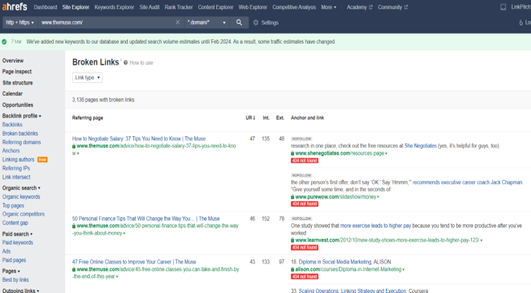
Ahrefs subscribers can also compile a Best by Links report under the Pages option in the Site Explorer tool.
In this example, the report lists pages with 404 page-not-found errors for TheMuse.com. It has 6,230 pages with broken external links. Each page URL listed is accompanied by the number of referring domains and a number of links to the page.
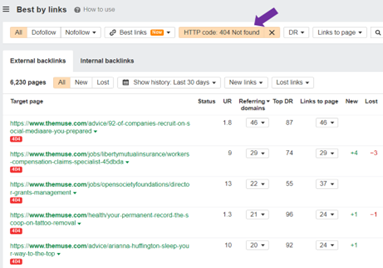
This research can identify the topics with the biggest potential to become the fixes for a broken link. You can create content to address them or identify content you already published. Just make sure the content closely matches the intent of the anchor text’s original link.
For example, the same research report, which is now a broken link, is cited in articles from Oyster and TINYpulse. On Oyster, the anchor text reads, “44% of companies did not allow remote work.” On TINYpulse, the anchor text says, “only 33% are very satisfied with the level of trust in their organization.”
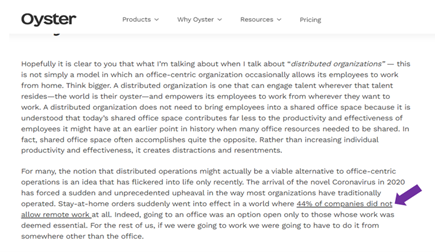
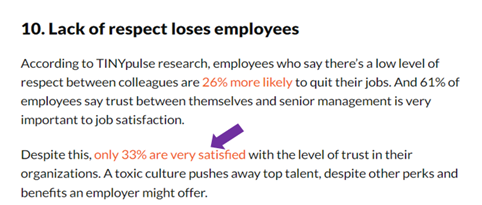
For a single article link to replace the broken link on Oyster and TINYpulse, the content would need to cite both a statistic about remote work and another stat about trust in organizations.
2. Guest posting
Like the broken-link replacement strategy, guest posting benefits both your and the recipient’s sites. You reach out to sites and offer to write content about a topic relevant to their audience that relates to your content subjects and includes a link to your site. This technique works well because you typically control where and how to add your link to make it as relevant as possible.
You can take multiple approaches to win guest-posting opportunities. No matter which tactics you use, track the sites and verify the site’s quality using Ahrefs, another tool, or a direct visit to the site.
First, you can use Ahrefs (or a similar tool) to examine your competitors’ backlinks and identify any links that come from guest posts. The anchor or surrounding text might hint at its status with phrases such as “contributed by,” “guest post by,” or the name of the brand or author. You also can check links manually to see if they’re contributed content.
In this example from Collegiate Parent, the headline reads “EFC Too High? Tips for Successful Aid Appeals” and includes a byline for “Billie Jo Weis.” At this point, you don’t know if it is a contributed article.

But scroll down to the end, and you can see the author’s bio. It confirms the article is a guest post because her bio says she is a client services advisor for My College Planning Team, not the publisher (Collegiate Parent).

You can also use Google search operators to identify sites open to guest contributions. You’ll want to do several searches using variations of your target keywords and topic accompanied by phrases, such as “guest post,” “contributed by,” “guest post by,” and “guest posting guidelines.”
The example in the screenshot below works for a brand targeting college prep topics. The search is “’college prep’ ‘guest post by’ -site.pinterest.com.” The results reveal four articles from four sites that use the words “college prep” and “guest post by.” You can add those sites to your outreach tracker.

Finally, you can list sites relevant to your niche that didn’t appear in the earlier searches.
TIP: Not all sites that accept guest articles say so on their website.
3. Niche edits
A niche edit, sometimes referred to as a link insert, is a technique that adds a link to existing content. The key to success is finding relevant articles on high-quality sites and pitching your content as a valuable addition to those articles.
You can use a similar process to the Google guest post search. Input a broad keyword for your targeted keyword, then tell it you don’t want the targeted keyword in the title. If the entire article is about your targeted keyword, your chances of getting the publisher to include a link to a similar article are low.
Here’s an example from one of our client’s that sought to make niche edits for the keyword “soft skills.”
The Google search included these phrases:
- “Organizational development” soft skills -intitle:”soft skills”
- “Organizational development” soft skills employee training -intitle:”soft skills”
- Soft skills employee training -intitle:”soft skills” organizations
It led to an added link for “soft skills” in this article — “Employee Development,” which includes the header, “What are the benefits of employee development for an organization?”
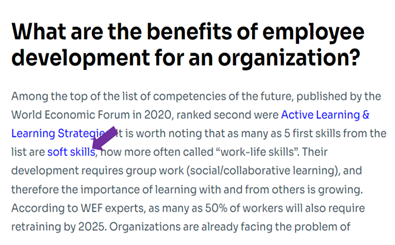
You can do several searches, modifying your search operators each time to see what sites and content appears. Think of multiple angles to broaden the potential sites that publish content with your targeted or a related keyword.
After you’ve crafted a list of high-quality prospects, it’s time for outreach.
Niche edits might be the hardest of the three strategies to achieve because they’re not as clear of a win-win situation as the other two (repairing broken links and publishing new content).
Your email pitch can make or break your niche-edit campaign. It must convince the publisher that your content provides so much value that they will want to take an extra step with content they’ve already completed.
Here are some tips to craft a link-earning email pitch:
- Start by mentioning something about them. It could be something you like about their website or the article you’re targeting. You want them to know you’ve explored their site and read the article. But don’t overdo it. A simple compliment or sentence about how you found the article helpful should suffice.
- Introduce your content and mention how it can help their audience. Be concise and convincing, but don’t oversell it.
- Go one step further and point to a section or sentence where you think your content might be a good fit. This will help them see where your content can add value and link to it.
Get linking
Though contextual link building may seem challenging to execute, it can bring great rewards. Follow these tips and strategies, and your valuable content will get more attention from external sites and eventually Google rankings where it deserves to be.
All tools mentioned in this article are identified by the author. If you have a tool to suggest, please tag CMI on social.
HANDPICKED RELATED CONTENT:
Cover image by Joseph Kalinowski/Content Marketing Institute
MARKETING
Google’s Surgical Strike on Reputation Abuse
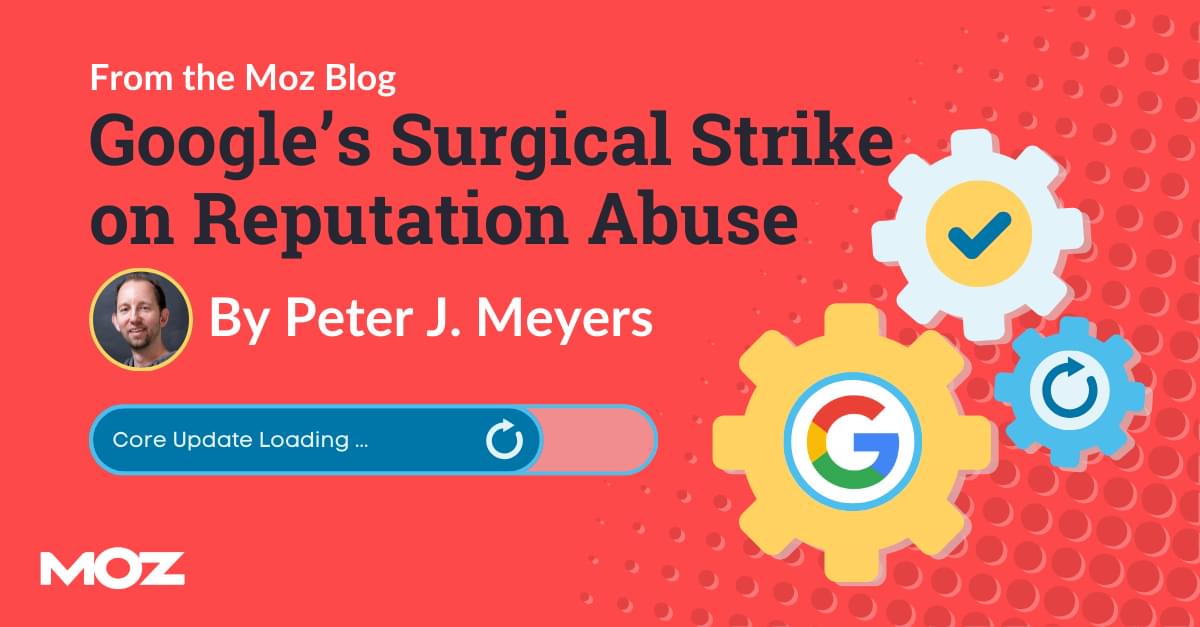
These aren’t easy questions. On the one hand, many of these sites do clearly fit Google’s warning and were using their authority and reputation to rank content that is low-relevance to the main site and its visitors. With any punitive action, though, the problem is that the sites ranking below the penalized sites may not be of any higher quality. Is USA Today’s coupon section less useful than the dedicated coupon sites that will take its place from the perspective of searchers? Probably not, especially since the data comes from similar sources.
There is a legitimate question of trust here — searchers are more likely to trust this content if it’s attached to a major brand. If a site is hosting third-party content, such as a coupon marketplace, then they’re essentially lending their brand and credibility to content that they haven’t vetted. This could be seen as an abuse of trust.
In Google’s eyes, I suspect the problem is that this tactic has just spread too far, and they couldn’t continue to ignore it. Unfortunately for the sites that were hit, the penalties were severe and wiped out impacted content. Regardless of how we feel about the outcome, this was not an empty threat, and SEOs need to take Google’s new guidelines seriously.
-

 MARKETING6 days ago
MARKETING6 days agoAdvertising on Hulu: Ad Formats, Examples & Tips
-

 MARKETING3 days ago
MARKETING3 days ago18 Events and Conferences for Black Entrepreneurs in 2024
-

 WORDPRESS6 days ago
WORDPRESS6 days agoBest WordPress Plugins of All Time: Updated List for 2024
-

 MARKETING7 days ago
MARKETING7 days agoUpdates to data build service for better developer experiences
-

 WORDPRESS7 days ago
WORDPRESS7 days agoShopify Could Be Undervalued Based On A Long-Term Horizon
-

 PPC7 days ago
PPC7 days agoLow Risk, High Reward YouTube Ads alexking
-
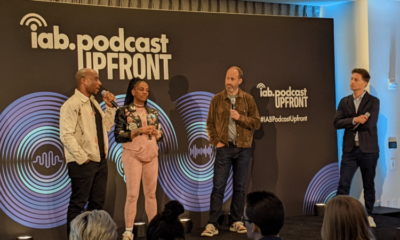
 MARKETING4 days ago
MARKETING4 days agoIAB Podcast Upfront highlights rebounding audiences and increased innovation
-

 WORDPRESS5 days ago
WORDPRESS5 days ago5 Must See Telegram Plugins for WooCommerce















